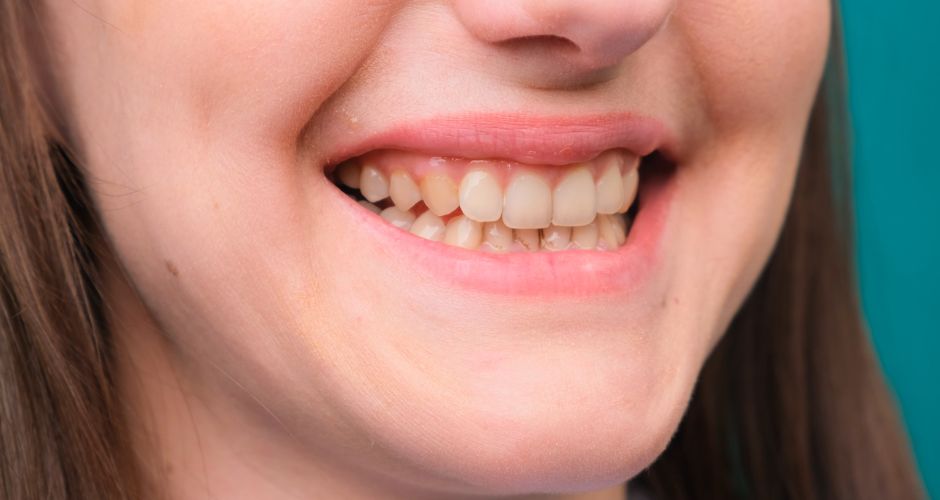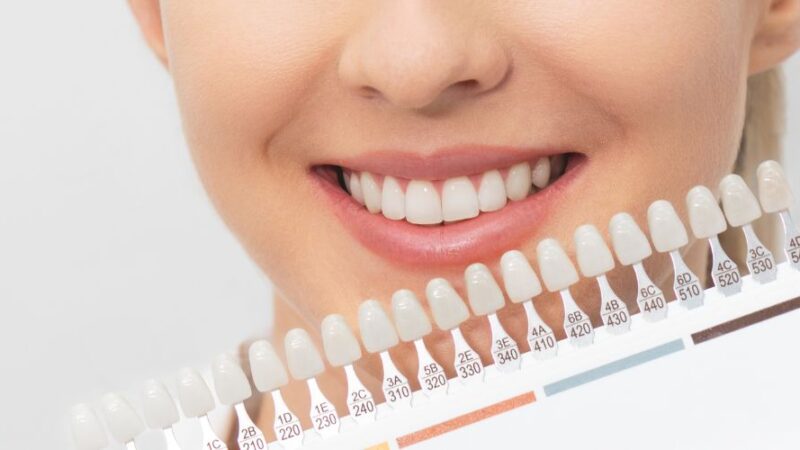What Causes Yellow Stains on Teeth?

A dazzling, white smile is often considered a symbol of good health and confidence. However, yellow stains on teeth can detract from this image, causing embarrassment and self-consciousness.
Understanding the underlying causes of tooth discoloration and exploring effective treatment options is essential for achieving a brighter, whiter smile. In this comprehensive article, we’ll delve into the various factors that contribute to yellow stains on teeth and discuss practical strategies for achieving a radiant smile.
Causes of Yellow Stains on Teeth
- Poor Oral Hygiene: Effective oral hygiene practices, such as brushing and flossing, are crucial for maintaining healthy teeth and gums. When oral hygiene is neglected, plaque and tartar can accumulate on the surface of teeth, leading to yellow staining. Plaque is a sticky film of bacteria that forms on teeth, while tartar is hardened plaque that cannot be removed with regular brushing and flossing.
- Food and Beverages: Certain foods and beverages contain pigments called chromogens, which can adhere to the enamel of teeth and cause staining. Coffee, tea, red wine, and dark-colored fruits such as berries are common culprits. Additionally, acidic foods and drinks can erode the enamel, making it more susceptible to staining.
- Tobacco Use: Smoking cigarettes or using other tobacco products exposes teeth to nicotine and tar, which can cause yellow staining and discoloration. Tar is a sticky substance that adheres to tooth enamel, while nicotine can contribute to the formation of plaque and tartar.
- Aging: As we age, the enamel on our teeth naturally wears down, revealing the yellowish dentin layer underneath. Dentin is the hard tissue beneath the enamel that makes up the bulk of the tooth structure. As the enamel becomes thinner with age, the yellow color of the dentin becomes more prominent, leading to a duller appearance of the teeth.
- Medications: Certain medications, such as tetracycline antibiotics and antihistamines, can cause tooth discoloration as a side effect. Tetracycline antibiotics, when taken during childhood, can permanently stain developing teeth, leading to yellow or grayish-brown discoloration.
- Dental Trauma: Injury or trauma to the teeth, such as a fall or impact, can disrupt the development of tooth enamel and lead to discoloration. Immediate discoloration may occur as a result of bleeding within the tooth, while long-term discoloration may develop as a response to the trauma.
- Genetics: Genetic factors can play a role in determining the color and thickness of tooth enamel. Some individuals may inherit genes that result in naturally thinner or more translucent enamel, making the yellowish dentin layer more visible. Additionally, genetic conditions such as amelogenesis imperfecta or dentinogenesis imperfecta can cause abnormalities in tooth enamel formation, leading to discoloration.
Treatment Options for Yellow Stains on Teeth

- Professional Teeth Whitening: Professional teeth whitening treatments performed by a dentist are one of the most effective ways to lighten yellow stains and restore a brighter smile. These treatments typically involve the use of bleaching agents such as hydrogen peroxide or carbamide peroxide, which penetrate the enamel to break down stains and lighten the color of the teeth.
- Over-the-Counter Whitening Products: Over-the-counter whitening toothpaste, strips, and gels can help reduce surface stains and lighten the color of teeth. These products typically contain mild abrasives or peroxide-based bleaching agents that work to remove stains and brighten the enamel. While over-the-counter whitening products may not be as effective as professional treatments, they can be a convenient option for maintaining a whiter smile at home.
- Dental Cleanings: Regular dental cleanings performed by a dental hygienist are essential for removing plaque, tartar, and surface stains from teeth. During a dental cleaning, the hygienist uses specialized instruments to remove buildup from the surface of the teeth, leaving them cleaner and brighter. Dental cleanings should be scheduled every six months to maintain optimal oral health and prevent the progression of staining.
- Avoiding Staining Foods and Beverages: Limiting consumption of foods and drinks that are known to cause staining can help prevent further discoloration of teeth. Coffee, tea, red wine, dark-colored berries, and acidic foods should be consumed in moderation, and teeth should be brushed or rinsed with water after consumption to minimize staining.
- Quitting Tobacco Use: Quitting smoking or using tobacco products is essential for improving overall health and reducing yellow stains on teeth caused by tobacco smoke. Nicotine and tar in tobacco smoke can adhere to tooth enamel, causing yellow discoloration and increasing the risk of gum disease and oral cancer. Quitting tobacco use can lead to whiter, healthier teeth and gums over time.
- Dental Bonding or Veneers: For more severe cases of tooth discoloration or staining that does not respond to traditional whitening treatments, dental bonding or veneers may be recommended. Dental bonding involves applying a tooth-colored resin material to the surface of the teeth to improve their appearance, while veneers are thin shells made of porcelain or composite material that are bonded to the front surfaces of teeth to cover imperfections and create a brighter smile.
- Lifestyle Changes: Adopting good oral hygiene habits and making healthy lifestyle choices can help prevent yellow stains on teeth and maintain a bright, white smile. Brushing teeth twice a day with fluoride toothpaste, flossing daily, and using an antiseptic mouthwash can help remove plaque and bacteria from the teeth and gums, reducing the risk of staining and decay. Additionally, drinking plenty of water, eating a balanced diet rich in fruits and vegetables, and avoiding sugary and acidic foods can help keep teeth healthy and prevent discoloration.
Conclusion
Yellow stains on teeth can detract from the appearance of your smile and impact your self-confidence. However, with proper understanding of the causes of tooth discoloration and access to effective treatment options, achieving a brighter, whiter smile is within reach.
By addressing underlying factors such as poor oral hygiene, dietary habits, and tobacco use, and exploring treatment options such as professional whitening treatments, dental cleanings, and lifestyle changes, you can restore your smile and enjoy optimal oral health for years to come.
Recommended – Effective Home Remedies for Cleaning Dentures






